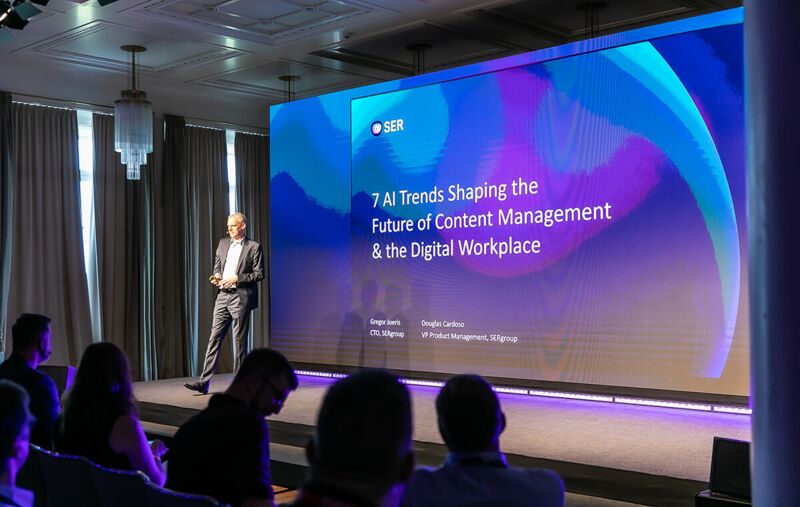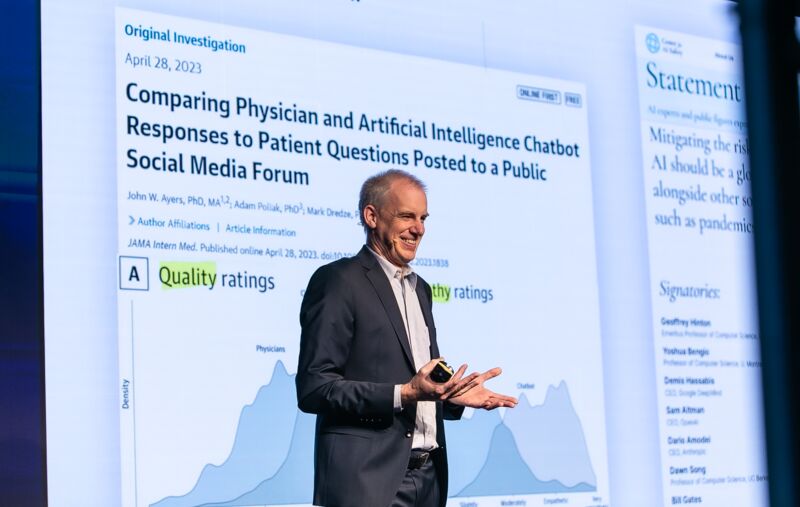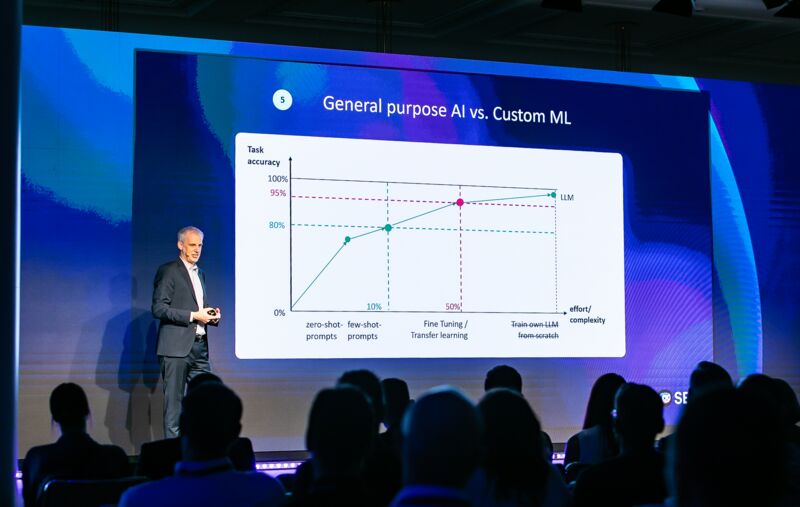SER Blog Innovation & Technology
7 AI trends shaping the future of content management and the digital workplace
| Victoria McEwan
AI really is having its moment and our most recent jam-packed SER Summit showcased the power of technology in content management with talks such as, ‘Leveraging the Unknown: Harnessing 80 Million Objects to Transform the Study of Natural History’ with Dr. Steen Dupont of The Natural History Museum, London and ‘Cracking the Code on Intelligent Content Automation’ with our CEO, Dr. John Bates.

Our CTO Dr. Gregor Joeris also explored ‘7 AI Trends Shaping the Future of Content Management and the Digital Workplace’ and in this blog, we’ll break down each of the seven trends discussed and the role they’re playing in the ever-evolving Doxis product ecosystem.
Seven AI trends shaping the future of content management and the digital workplace
Trend 1: Composable AI, the result of on-going AI innovations
AI has been making an impact across industries for quite some time now, but in the past year, its popularity and potential has skyrocketed. The sheer size of the AI ecosystem is constantly growing and evolving. AI is continuing to revolutionize the way we work – from reducing costs to automating processes – and the AI market has an expected annual growth rate of 37.3% between 2023 and 2030 (GrandViewResearch). This showcases just how big the impact of AI technology is going to be, and it’s showing no signs of slowing down…

How does this relate to Doxis? AI is an ever-changing industry and what is popular and thriving right now, could be drastically different in just a few months. You might wonder... "But with everything evolving so quickly, what if the application that I pick, or the vendor I use, isn't utilizing the most capable systems in a few months? Will I be missing out on what the best technology offers?"
Here at SER, you don’t need to worry about keeping up with the latest and greatest tools. We do that for you. We’re always ahead of the game, and we make sure we’re always using the current, most secure and best-in-class tools to ensure you’re always getting the best experience. We call this strategy ‘composable AI’.
Trend 2: Responsible AI
From incredibly realistic AI-generated images and videos to potential data risks, AI is front and center of political talks with newly proposed rules and regulations to ensure that AI impacts people in a positive way. The EU has proposed the AI Act and British Prime Minister, Rishi Sunak has announced he wants the U.K to be a key player in global AI regulation in light of the potential risks.
Seven technology giants, the likes of Google, Open AI and Microsoft, have agreed to AI safeguards to ensure products are security-led and safe for public use.
How does this relate to Doxis? As discussed at the SER Summit, the primary function of Doxis as a platform is to utilize the power of general purpose AI to manage your content, supercharge your business operations, and provide dedicated and special use cases for your business and data - that do not pose any risks or threats.
AI is a wonderful helping hand, but we can’t always explore the reasons behind its answers and the journey it takes to get there, which is why the human experience is essential. Therefore, we always offer human validation options to ensure reliable, traceable and high-quality AI results.
Doxis works with Azure Open AI who have stringent data protection rules, so you can feel secure knowing that they do not store or retain any of your data. Your data is yours, and you can be assured that it stays that way.

Trend 3: Generative AI
What is generative AI?
Generative AI is the use of machine-learning algorithms that people can use to generate new and exciting content and ideas. This can range from creating code, images and videos as well as text… ChatGPT we’re looking at you. Large language models (LLM) such as ChatGPT use natural language processing (NLP).
Generative AI incredibly powerful and on the rise. In the first 5 days after its launch, for example, ChatGPT exceeded 1 million users (Greg Brockman, Co-Founder of OpenAI). But why is it so powerful for businesses?
Generative AI can really transform the way your employees work. It can give you answers to questions about the data in your documents, provide summaries of content and get your projects well underway by triggering and organizing workflows. All of this has a profound impact on productivity, knowledge sharing and engagement in the workplace.
How does this relate to Doxis? Doxis Intelligent Content Automation and AI-assisted features are the ultimate tools to assist you with your work tasks.
Let’s say you work in insurance, and you receive an email from a customer about creating an insurance claim. Our friendly assistant Doxi instantly analyzes the data and makes suggestions about your next steps, whether that’s searching for the insurance number in Doxis or asking to create a process in Doxis.
You can have conversations with Doxi where you’ll get immediate assistance and answers. Dealing with large amounts of data can be overwhelming, but with Doxi by your side, you can stay organized and thrive.
Trend 4: Prompt Engineering
To make the most of generative AI, you must be able to optimize prompts to get the results you need… aka prompt engineering. It’s all about communicating effectively with machines by using optimized natural language and providing them with all the information they need for the task to be performed correctly. Done right, you really reap the rewards.

How does this relate to Doxis?
Doxis is home to a library of Fast Starters with additional which contain predefined sets of prompts that can be used in specific contexts relevant to your needs. These prompts use LLMs to empower individuals to start using digital solutions at the click of a button. No coding experience required. The good news is, Prompt Fast Starters will be available in early 2024.
Trend 5: General-purpose AI vs custom ML
What is general purpose AI?
General-purpose AI (GPAI) are systems that have a wide application of uses that can be applied to a range of different tasks and do not require any modification or fine-tuning.
For example, a general-purpose AI system for language processing can be used for translation, creating chatbots, decision-assisting and more. GPAI has a lot of memory and data and are great at applying knowledge from one task to another.
General-purpose AI models are ready to go, cost-effective and fast-acting, but these aren’t always the best option when you’re a business that need specific requirements. This is where custom models come in. Here you can leverage general-purpose AI and tailor it to your business documents through training.
We did this with SEW-EURODRIVE, helping them to automate document processing globally...
“It would be really hard to do this without AI. We take 100 sample documents in a region and train them, and then the system does the classification themselves,” says Benjamin Schaller, Group Manager of Archiving and Documenting Services at SEW-EURODRIVE.
By scaling the platform and automating processes, SEW-EURODRIVE was able to achieve time savings of 90% after three years, give employees instant access to information and facilitate greater flexibility in their customer service processes – all through AI-powered process management.
Find out how you can make the most out of your return on information by reading our study with SEW-EURODRIVE and Forrester Consulting.

How does this relate to Doxis? Gregor captured the combination of both AI models perfectly in the talk: “We always use an existing large language model but adapt that for your own use case. What we are doing is we try to optimize and automate that for use with Auto ML. So, with the documents you have in Doxis, we automatically fine-tune such a model for you so that you do not need to label data and have all the manual effort of training a system.”
Trend 6: Multimodal recognition for documents
Multimodal AI is going to transform the way we interact with technology and information in the workplace. In the age of varied content, having multimodal machine-learning models means that users can extract and understand data to get a clearer understanding of business-critical information.
While many vendors offer MML, we recognize the importance of accurate and trusting data and therefore combine multiple systems (MML, Rules and Contextual AI) to give you true, quality data. Combining systems give you reliable and powerful results that leave the need for manual validation behind and give you trusted data predictions.
How does this relate to Doxis? At SER we integrate with Azure Form Recognizer, a typical multimodal, pre-trained model for layout and text. In addition to this you’re able to utilize recognition engines which are based on rule sets as well as fuzzy matching on supplier data.
Trend 7: Combining composable AI & contextual AI in Doxis
What is contextual AI?
When we talk about contextual AI it is a concept rather than a specific piece of technology.
Contextual AI is all about benefitting from the wisdom generated through past experience or contextual information, for example the documents stored in your DMS, ERP or CRM will contain a wealth of information from metadata and the way content is structured.
Doxis uses this information to gather context (contextual AI) around certain pieces of content and assists in validating this information, resulting in a high level of quality and exactness for your data.
Let’s take an invoice... factors like vendor information, previous invoices, financial figures, dates, key contacts and even communication channels around invoices can be gathered with ease from your systems.
Imagine an invoice is sent via email, but the amount is drastically higher than what invoices usually are… Is there an error? Does the person dealing with the invoice notice the figure is different than usual? Doxis integrating with your systems means that through content understanding your data is accurate and processes run smoothly without error.
How does this relate to Doxis? Combining composable and contextual AI is where the magic happens. By always having access to the best-in-class AI systems and having Doxis Intelligent Content Automation there to provide you with business-critical data from your ERP in minutes, you’ll be able to get a crystal-clear understanding of your company’s data.
Data validation is made quick and easy, and you’ll be able to understand your data, gather insights and make decisions based on content like never before. AI will be able to spot potential anomalies in data that can be validated and checked – leaving no margin for error, saving on costs and ensuring employees are satisfied that they are doing a good job. It’s an incredible combination.
Didn't get a chance to attend the SER Summit?
You can watch the full video here where Gregor explores the seven trends in depth.
Want to learn more about the world of AI and Doxis? Discover a new era of content understanding with Doxis, here.
Can’t get enough? Our blog offers all the latest innovations in AI and tech from interviews on how academia and industry collaborate on AI research to how Doxis is powering collaboration.
The latest digitization trends, laws and guidelines, and helpful tips straight to your inbox: Subscribe to our newsletter.
How can we help you?
+49 (0) 30 498582-0Your message has reached us!
We appreciate your interest and will get back to you shortly.




